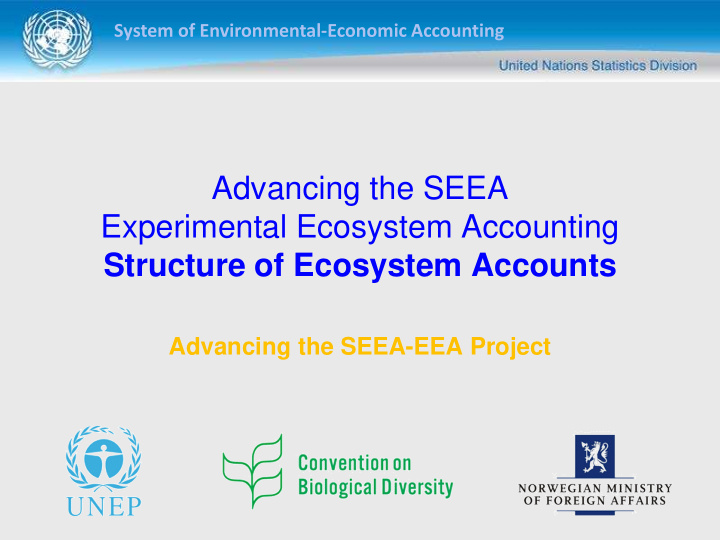



System of Environmental-Economic Accounting Advancing the SEEA Experimental Ecosystem Accounting Structure of Ecosystem Accounts Advancing the SEEA-EEA Project
System of Environmental-Economic Accounting Why is a set of accounts needed? • To organise information recognising breadth of information set and multiple perspectives ▫ Stocks and flows – different accounting identities ▫ Spatial units and beneficiaries ▫ Physical and monetary measures • To integrate with economic data ▫ Key feature of the SEEA ▫ Recognise linkages between accounts and between assets and services • To support communication of information and further analysis 2
System of Environmental-Economic Accounting General features of SEEA EEA accounts • National level coverage, multiple ecosystem types and multiple ecosystem services • Able to integrate with standard economic data and apply accounting identities • Compiled regularly • In design assume data available, focus on communicating significant trends/structures in an aggregate context 3
System of Environmental-Economic Accounting Proposed accounts for EEA TG (T 4.1) 4
System of Environmental-Economic Accounting SEEA-EEA accounts and linkages (Fig 4.1) Physical Accounts (by spatial unit) Ecosystem Ecosystem Ecosystem Ecosystem Ecosystem Extent Condition Services Services Capacity Account Account Supply Use Account Account Account Ecosystem component accounts: Land, Carbon, Water, Biodiversity Supporting information: Socio-economic conditions and activities, ecological production functions Tools: classifications, spatial units, scaling, aggregation, biophysical modelling Monetary Accounts (by spatial unit) Ecosystem Services Augmented I-O Table Ecosystem Asset Supply Account Account Ecosystem Services Use Integrated Sector Accounts Account and Balance Sheets Supporting information: SNA accounts, I-O tables Tools: Valuation techniques 5
System of Environmental-Economic Accounting Primary dimensions of each account Ecosystem extent account • Unit: hectares • Dimensions: Ecosystem asset (spatial units) X Open/close/change in stock Ecosystem condition account • Unit: mixed depending on characteristic/indicator • Dimensions: Ecosystem asset (spatial units) X Characteristic/indicator 6
System of Environmental-Economic Accounting Primary dimensions of each account Ecosystem services supply account • Unit: mixed depending on ecosystem service / currency units • Dimensions: Ecosystem asset (spatial units) X Type of ES (e.g. CICES) Ecosystem services use account (physical) • Unit: mixed depending on ecosystem service / currency units • Dimensions: Beneficiaries (industry/sector) X Type of ES (e.g. CICES) 7
System of Environmental-Economic Accounting Primary dimensions of each account Ecosystem capacity account • Unit: mixed • Dimensions: Ecosystem asset (spatial units) X ?? Ecosystem asset account (monetary) • Unit: currency unit • Dimensions: Ecosystem asset (spatial units) X Open/Close/Change in stock 8
System of Environmental-Economic Accounting Primary dimensions of each account Augmented I-O or SU table • Unit: currency units • Dimensions: Products & ES X Industry & Ecosystem assets Sequence of accounts and balance sheets • Unit: currency units • Dimensions: National accounts sequence + degradation X Institutional sector 9
System of Environmental-Economic Accounting Issues: Decision and advice Which accounts should be included in a set of ecosystem accounts? What names should be given to each of the accounts? Does the proposed sequencing of the accounts match the: • requirements for information • availability of source data / methods What advice should be provided to countries in terms of which accounts are of highest priority? 10
System of Environmental-Economic Accounting Issues: Testing Is there an appropriate scale for the purposes of international comparison? What is the appropriate structure for the ecosystem condition account? What options are available for the aggregation of physical measures of condition? What classification of ecosystem services should be used in the ecosystem supply and use accounts? What are the implications for the compilation of component accounts (carbon, water, biodiversity, etc)? 11
System of Environmental-Economic Accounting Issues: Research How should ecosystem capacity be defined and what links can be drawn to the calculation of the net present value of ecosystem assets? What would the structure of an ecosystem capacity account look like? How should ecosystem degradation be defined, valued in monetary terms and attributed to economic units? How should expenditure on ecosystem enhancement be treated from a national accounting perspective? Are the proposed integrated accounts appropriate and relevant in terms of linking ecosystem accounting with the SNA? 12
System of Environmental-Economic Accounting Topics for breakout groups 1. The structure of the ecosystem condition and ecosystem services accounts 2. Implications for the structure of the condition and services accounts for component accounts (carbon, water, biodiversity) 3. Ecosystem capacity – definition, links to measuring ecosystem assets, capacity account structure 4. Ecosystem degradation – definition and valuation 5. Integration with the national accounts – attributing degradation, treating ecosystem enhancement and structuring integrated accounts 6. Indicators from ecosystem accounting – what is possible? 13
System of Environmental-Economic Accounting Acknowledgements This project is a collaboration of The United Nations Statistics Division, United Nations Environment Programme and the Secretariat of the Convention on Biological Diversity and is supported by the Government of Norway.
Recommend
More recommend